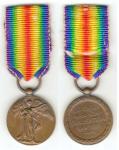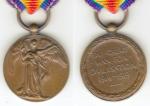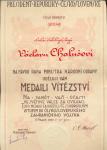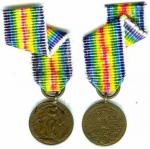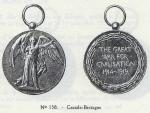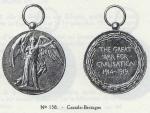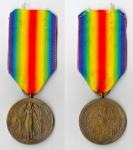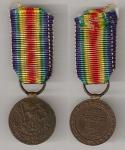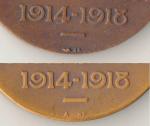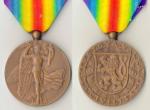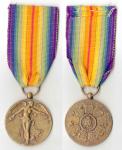-
Posts
1,169 -
Joined
-
Last visited
-
Days Won
1
Content Type
Profiles
Forums
Blogs
Gallery
Events
Store
Everything posted by RobW
-
To all, The closest thing I have to such a French repro is a French produced British victory medal miniature. It was picked up from a French dealer in Paris. It is suspended by a ball suspender and looks close to that above. While it is suspended from French style vic miniature ribbon that, in itself, is not an indicator of anything. Happy for any thoughts on the issue. Regards, Ro
-

French reproduction British Victory medal
RobW replied to RobW's topic in Great Britain: Orders, Gallantry, Campaign Medals
-

French reproduction British Victory medal
RobW replied to RobW's topic in Great Britain: Orders, Gallantry, Campaign Medals
To all, The closest thing I have to such a French repro is a French produced British victory medal miniature. It was picked up from a French dealer in Paris. It is suspended by a ball suspender and looks close to that above. While it is suspended from French style vic miniature ribbon that, in itself, is not an indicator of anything. Happy for any thoughts on the issue. Regards, Rob -
To all, For those that have not seen a colour pic of one, here is an award certificate for the Czech victory medal. In this case it is to a soldier of the Czech-Italian Legion. When I can find my similar certificates for the Czech-Russian and Czech-French Legion I shall post pics of them as well. The earliest certificate I have seen is dated August 1922 with this one dated in 1935 one of the latest that I've seen. Any comments on later dates or higher numbered awards would be gratefully received. Regards, Rob
-
To all, I have recently posted pics of a Brazil vic both full size and mini on the Victory medals of the world thread. Regards, Rob
-

Brazilian Victory Medals
RobW replied to RobW's topic in Inter-Allied Victory Medals of the Great War
To all, Here is the accompanying miniature for the Brazil vic. Produced in France it is not often found. The diameter is 15.5mm. More to follow. Regards, Rob -

South African Victory Medals
RobW replied to JPL's topic in Inter-Allied Victory Medals of the Great War
Hello Jean Paul, I obtained both specimens via the Royal Mint at Pretoria, South Africa. As far as I can recall they were minted at the Woolwich Arsenal in England and then shipped to the Mint at Pretoria, for subsequent naming in location, and distribution to the recipients. I obtained the pieces from stock that were left over and hadn't been issued; hence they are unnamed. In recent times there has also been a number of unnamed 1914-15 Stars and British War medals floating around the market that are left of these unissued, unnamed stocks. You are indeed correct that the type 2 are less plentiful than the type 1. While I don't have an accurate figure on type differences I have seen less than 5 type 2's South Africans amongst a sea of type 1's. Glad the pictures were of use. Regards, Rob -

South African Victory Medals
RobW replied to JPL's topic in Inter-Allied Victory Medals of the Great War
Reverses as indicated. Reverse; minor variations in the positioning of the circular wreath in relation to the rim edge of the medal, minor differences in the position, spread and spacing of the bilingual inscriptions, this being noticeable where it abuts the internal circular wreath, and a smaller gap where the delineating dots separate the two languages. Overall the differences are of a minor nature. Blink and you'll miss them but they are there nonetheless. I hope this helps. Regards, Rob -

South African Victory Medals
RobW replied to JPL's topic in Inter-Allied Victory Medals of the Great War
In answer to Jean Paul's inquiry here are the South African Official type 1 and type 2 from my collection. Official type 1 on the left with type 2 on the right. Both are unnamed as issued. The differences are: General; the official type 1 has a much more pronounced and noticeable plinth on which the barrel suspender is attached. This is much less noticeable or prominent on the type 2. While I haven't been able to confirm it, it does appear that they are made from different base metals. It looks like the type 2 was a slightly heavier strike resulting in more pronounced detail. Obverse; minor variations in victory herself showing in the detail of the face, the top garment, the internal wing leaf detail, the flowing robes, and where the robes finish at the base of the medal, with minor differences in the base platform. The major difference is the lack of the designers initials 'W.McM' on the obverse. Reverses to follow. Regards, Rob -
-
Hello Tim, As indicated before here is the other variety. It is the same diameter and made of the same material. Again apologies for my poor scanning attempt. Reverse to follow. Regards, Rob
-
To one and all, I am attempting to confirm or deny if a French made reproduction of the Great Britain Victory medal for the Great War was ever produced. I am not sure if to post here or in the Great Britain forum so will choose both. This victory medal is depicted as illustration no. 158 on page 45 of M. Delande's 1934 Paris work 'Les Ordres Fran?ais, Les Ordres Coloniaux, M?dailles Comm?moratives, M?dailles d'Honneur des Minist?res, Les Croix et M?dailles, de la Guerre 1914-18, des Pays Alli?s'. Of note is that most of the interallied victory medal series are illustrated in this work, and there exist many specimens of these repro's including the Japanese, Czech, Greek, and US versions, as well as possibly the Belgian model. It is depicted with a ball suspender which was common for most of the produced and seen French repro's and it is most likely to have BRONZE on the edge and the hallmark of M. Delande (a small square or more likely a lozenge shaped hallmark). I have attached a copy of the illustration in question, taken from an original 1934 copy of the catalogue (and a very fragile book it is; but it has such marvelously wonderful drawings especially of the Colonial decorations !). Have any collectors identified an actual specimen of this variety as it is still unconfirmed, through two editions of Mr Laslo's work and the ensuing 75 years? Can anyone help?? Regards, Rob
-
To one and all, I am attempting to confirm or deny if a French made reproduction of the Great Britain Victory medal for the Great War was ever produced. I am not sure if to post here or in the French forum so will choose both. This victory medal is depicted as illustration no. 158 on page 45 of M. Delande's 1934 Paris work 'Les Ordres Fran?ais, Les Ordres Coloniaux, M?dailles Comm?moratives, M?dailles d'Honneur des Minist?res, Les Croix et M?dailles, de la Guerre 1914-18, des Pays Alli?s'. Of note is that most of the interallied victory medal series are illustrated in this work, and there exist many specimens of these repro's including the Japanese, Czech, Greek, and US versions, as well as possibly the Belgian model. It is depicted with a ball suspender which was common for most of the produced and seen French repro's and it is most likely to have BRONZE on the edge and the hallmark of M. Delande (a small square or more likely a lozenge shaped hallmark). I have attached a copy of the illustration in question, taken from an original 1934 copy of the catalogue (and a very fragile book it is; but it has such marvelously wonderful drawings especially of the Colonial decorations !). Have any collectors identified an actual specimen of this variety as it is still unconfirmed, through two editions of Mr Laslo's work and the ensuing 75 years? Can anyone help?? Regards, Rob
-
Hello Hendrik, I have just posted some pics of a Siam vic on the Victory medals of the world thread. Regards, Rob
-
Here is a Brazil vic on loan to me; an official type 2 according to Mr Laslo's book (no edge mintmark). Regards, Rob
-

Thai/Siamese Victory Medals
RobW replied to RobW's topic in Inter-Allied Victory Medals of the Great War
-

Thai/Siamese Victory Medals
RobW replied to RobW's topic in Inter-Allied Victory Medals of the Great War
-
Here are a couple of pics of my Siam and a Brazil vic on loan for reference. Once I work with my temperamental scanner I'll post others. I hope these help. Regards, Rob
-
Hello Tim & Bison, Here is a close-up comparison of two of the official French vics in my collection showing the two different mintmarks. Regards, Rob
-
-
To all, For those not aware where the Leisek hallmarks are on the official type 1, they are located next to the hand of victory on the obverse and immediately following the date 1919 on the reverse. They will look like 'LA' dependent on the angle they are viewed. Regards, Rob
-
Hello Dirk, According to Mr Laslo's reference this type is classed as a Reproduction Type 1. It, as your picture shows, does not have the designers name 'O.Spaniel' on the obverse, as is seen by the picture at the top of this thread. It is suspended by a ball suspender instead of the cylinder or barrel suspender normally seen on the official issues. On the reverse the letters are thicker and the linden leavers are wider than those seen on the official issues. Some, but not all, of these repro's have a small triangle shaped hallmark, which will look like 'AC' inside a triangle with the word BRONZE in capitals somewhere on the edge. While this hallmark is usually seen at the 6 o'clock position it has also been seen in other positions on the rim. This hallmark is of the Paris firm of Adrean Chobillon. This Paris firm produced a lot of reproductions of a number of the Victory medal series. There is also a further variety of this reproduction, classed as the Reproduction Type 3 which is a cast version of the type you have displayed. It has a slightly pitted appearance and lessened detail and is slightly smaller in diameter. While this reproduction is more commonly seen with the accompanying French ribbon it is also seen with the later style of Czech victory ribbon (as is the case with your example, as well as the example at the start of this thread). This ribbon was introduced in the mid 1930's and is also seen on the Czech Re-issue Types. If you are at all interested in the Interallied Victory medal series I would suggest that you try and locate a copy of the late Mr Alexander Laslo's book 'The Interallied Victory Medals of World War 1', 2nd Edition, 1992. It is a must for the victory medal collector. When I have time this weekend I shall scan pictures of the example of the Repro Type 1 in my collection and post it here for your comparison. Hope this helps. Regards, Rob
-
-
Here is a Czech-Belgian Victory medal, unofficial type 1 It is produced by Alexander Leisek. It has the original coarse weave Czech ribbon that is commonly found on the Czech produced Belgian victory medals as well as early issues of the official Czech medal before the ribbon was later changed. Of note is the shallow strike of the designers name 'Paul Dubois' on the bottom obverse as well as the 'LA' hallmark inside the wreath held by victory. There is also an 'LA' hallmark just below the central wreath on the reverse. On some examples of the unofficial type 1 the mintmark, especially the reverse one, is quite weak and indistinct. In this instance both hallmarks are strong. Of note is that it is suspended by a small slightly flattened ball. Close-up pictures of both the obverse and reverse to follow. Regards, Rob
-
Tim, There is another version of this wearable medal in addition to that illustrated above. Its full title is 'Birmingham Peace Celebrations Medal 1914-19'. It has the same two-ring suspension and is also made of the same gilt-plated material. The other version has the same PAX VICTORIS obverse with a different reverse inscribed ?Birmingham Peace Celebration - The Great War 1914-1919? which surrounds a coat of arms, or city seal depicting two figures and a shield (no doubt related to the city of Birmingham). The detail escapes me at the moment. When I find the piece among my collection I shall post pics. This particular medal was one of a large number of similar local city commemorative medals that celebrated the arrival of peace at the end of the Great War. A number of other cities in England produced similar medals, including the City of Carlisle, City of Coventry, Plymouth, County Borough of Salford, County Borough of Sunderland among others. There were various designs but this particular type used PAX VICTORIS for the obverse of both of the designs. Both of the Birmingham medal types are not often seen with the variety illustrated above seen even less often. Regards, Rob


